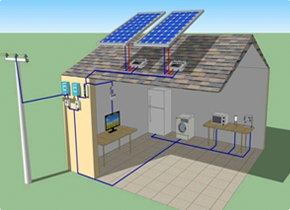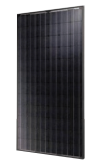Why choose solar energy? How does solar power work? Installation and Maintenance Financing your solar panel system System components
Whether or not solar power makes sense for you, now, more than ever is the best time to weigh your options and jump on the solar bandwagon. Sunshine is free, so why waste time paying the high costs of electricity if you can harness the sun’s energy to power your home at a lower cost?
The biggest benefit of generating your own free electricity, is that you can significantly reduce and sometimes completely eliminate your electric bill. By fixing your electricity rate, you can also protect yourself from unpredictable electricity rate price hikes, giving you independence and the ability to predict and manage expenses.
The installation of solar energy systems on residential properties increase the sales rate by 15-20%, demonstrating that home buyers consider the value of solar installations when shopping for a home. In addition, a new solar panel system usually adds property value that is equal to or greater than its original cost.
Solar panels should not be seen as an expense – they are one of the easiest ways to invest into your home and finances. Thanks to substantial electricity bill savings and financial incentives available today, the average HHS Group shopper pays off their solar panel system in 5 years and sees an ROI of 20% or more.
Our homes, vehicles and technologies require large amounts of energy, yet fossil fuel supplies are limited and cause pollution to our atmosphere. The sunshine has yet to let us down - which means we have a nearly infinite energy source. A typical residential panel system will eliminate 3 - 4 tons of carbon emissions annually, which the equivalent of planting 100 trees every year.
When sunlight hits an object on earth, the energy usually transforms into heat. However, when the same light hits certain materials, like the photovoltaic (PV) cells of a solar panel, that energy is converted to an electric current. Because the electricity generated by solar cells flows in a direct current (DC), an inverter must be used to change it into alternating current (AC) electricity, which is then ready to power a home.
Clouds do not completely block the rays of sunshine your solar panels need in order to function. Even on the cloudiest days, your solar panels will continue to generate electricity, albeit at a decreased rate. Think of it this way, if it is bright enough outside for you to be able to see using natural light, and your panels are not obstructed by shade, your solar equipment is still absorbing the indirect light filtering through the clouds.
You can choose to go completely off-grid, however most people stay connected to their utility for supplemental power. For systems that maintain a tie to the utility grid, the power meter measures the amount of energy used from the grid, as well as the amount of energy sold to the grid. This is known as net metering [link to blog] which allows owners of solar power systems to credit their excess power production toward future electric bills.
Solar panels have an expected lifetime of at least 25 years. In general, the life of the panels depends on the quality of the technology used and the quality of the overall installation.
All solar equipment comes with a warranty and a guarantee of production quality. Solar panels come with a 25 year preformance warranty, while inverters have a 10-25 year warranty, depending on the type of inverter. Product warranties are available for download on the HHS Group website. Installation warranties are dependent on your installer.

Solar panel systems can be installed on almost any roof. Your installer will inspect your roof and determine the best location for solar panels based on your roof size, pitch, materials, and direction towards the sun.
Ideally, solar panels should be placed facing south, or southwest and tilted towards the sun at a 90 degree angle. Houses that are shaded by trees and tall buildings, and houses that have a roof that needs extensive repair may not be suitable for solar power. To get a second opinion on your suitability for solar, register [link] with HHS Group to connect to a solar installer that will personally inspect your roof.
The ideal system size depends on the amount of available roof or ground space you have for your solar installation, the amount of electricity you want to produce, and the amount of money you are willing to spend. If you want to cover all of your energy needs with solar, take a look at your monthly electric bill and calculate your monthly/annual power usage. From there, you can determine your appropriat system size based on how much money you want to save on your electric bill.
At HHS Group, we connect you with multiple independent installers in your area, let you negotiate the installation price, and let you choose the installer you trust with your solar project. All the installers in our network have been pre-screened and verified to ensure their licensing, reputation, and experience meets the highest standards. For more tips on selecting an installer, read How to Choose a Solar Installer.
Fortunately, solar panels are considered low maintenance. Since there are no moving parts, the only maintanence required is brushing off debris and dirt a few times a year, and an occasional surface cleaning with a damp sponge or cloth. Though we generally don’t like rainy days, as they cause the panels to collect less power, you may welcome a few days of rain as your solar panels will be a lot cleaner when the skies clear.
The cost of solar is at an all time low today, and multiple financing options are available. Whether you are able to purchase your system upfront, get a solar loan, or enter a lease, you can start saving money as soon as you install your system.
Solar electric systems are typically sold by the watt. For example, if you were to purchase a 5000 watt system at $3.00 per watt your cost would be $15,000. If you pay income taxes you can enjoy a 30% tax credit on the total cost of the system. On a $15,000 system the tax credit would be $4,500 making the net cost of your solar electric system $10,500.
Buying a solar panel system with cash or even with a loan will lead to a much greater return on your investment in the long run. With a lease, homeowners can still save money and go solar with no money down; however, such agreements should only be considered when other purchasing options are just not feasable. Leasing arrangements can complicate home sales and many contracts contain an escalator clause that can reduce savings by increasing payments 3% per year In addition, homeowners are entitled to the 30% federal tax credit only when they actually own the solar powered system - with a lease that tax credit goes to the third-party. At HHS Group we give you wholesale prices, making buying attainable for many who think they cannot afford it.
Local, state, and federal governments all offer solar energy tax credits and rebates to encourage people to lower their energy usage and switch to renewable energy. The subsidy amount varies by program, but can cover at least 30% of your costs. To check for rebates and tax credits available in your area click here
Property assessed clean energy, or PACE, financing allows property owners to fund energy efficiency and renewable energy projects with little or no up-front costs. With PACE, residential and commercial property owners living within a participating district can finance up to 100% of their project and pay it back over time as a voluntary property tax assessment through their existing property tax bill.
1234

Solar panels vary in size, electrical output, efficiency, and even color; however, most panels are about 3’ by 5’ and have either a black or silver frame. Panels are typically mounted to a building’s roof or on a ground-mount racking structure. Solar panels are generally categorized as either monocrystalline or polycrystalline. Both types have the same function and are made from silicon cells, but the outward appearance and price of each is significantly different. Solar panels are given output ratings in watts. This rating is the maximum produced by the panel under ideal conditions.

An inverter is a device that changes the DC electricity produced by solar panels into AC electricity, which is then fed into the home’s electrical system. There are several different types of inverters. Micro inverters convert electricity from only one panel and need to be installed on each individual panel. String inverters convert electricity from multiple panels or a string of panels, and thus work better for systems that are not partially shaded throughout the day.

The monitoring system consists of meter and the electric panel. This system allows you to view and measure the production and efficiency of your solar powered system. For systems that maintain a tie to the utility grid, the power meter measures the amount of power used from the grid. In systems designed to sell power the utility, the power meter also measures the amount of power the solar system sends to the grid.

A racking system is used to mount solar panels onto a roof or attach them to the ground. Racking allows an installer to adjust and angle solar panels for optimal performance and also helps to attach the array to your roof without causing damage. Racking equipment will vary slightly depending on roof type.